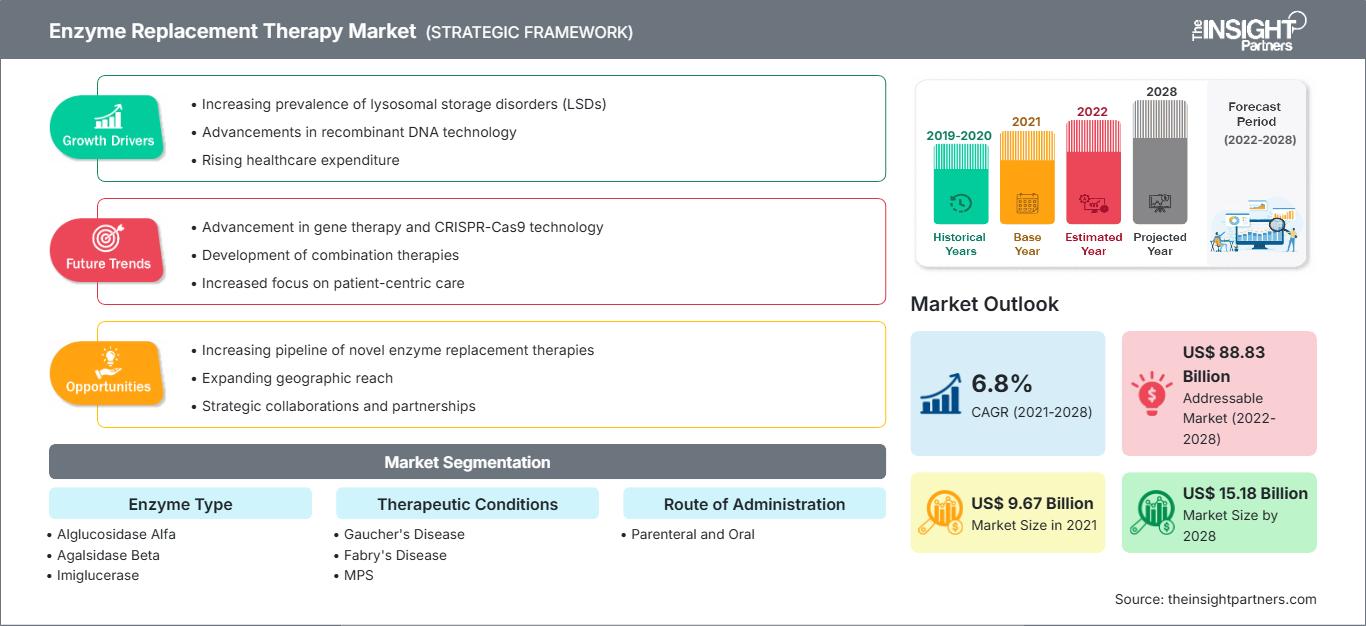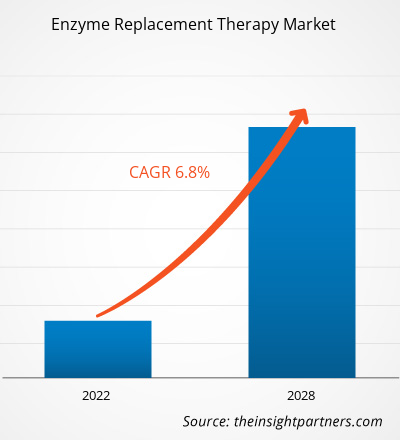Le marché de la thérapie enzymatique substitutive devrait passer de 9 673,39 millions de dollars américains en 2021 à 15 184,70 millions de dollars américains en 2028 ; sa croissance devrait atteindre un TCAC de 6,8 % entre 2022 et 2028.
La thérapie enzymatique substitutive (TES) est utilisée pour traiter les déficits enzymatiques congénitaux en utilisant une enzyme ou une protéine ayant une activité enzymatique. Les enzymes animales, humaines et recombinantes sont quelques-unes des sources d'enzymes nécessaires au traitement. Cette thérapie est généralement appliquée aux maladies rares et aux maladies de surcharge lysosomale, notamment la maladie de Pompe, la maladie de Fabry, la maladie de Gaucher, la maladie de Tay-Sachs et le syndrome de Hurler. La méthode TES la plus courante est la perfusion intraveineuse, dans laquelle l'enzyme de remplacement est administrée directement dans la circulation sanguine par un goutte-à-goutte contrôlé de liquides. La croissance du marché mondial des thérapies enzymatiques substitutives est attribuée à la prévalence croissante des maladies lysosomales (MSL) et à la rapidité de l'approbation réglementaire, ainsi qu'à d'autres avantages marketing pour les médicaments bénéficiant de la désignation de médicament orphelin. Cependant, la concurrence acharnée entre les acteurs du marché freine sa croissance.
Ce rapport offre des informations et une analyse approfondie du marché mondial des thérapies enzymatiques substitutives, en mettant l'accent sur divers paramètres, notamment les tendances du marché, les avancées technologiques, la dynamique du marché et l'analyse du paysage concurrentiel des principaux acteurs mondiaux. Il inclut également l'impact de la pandémie de COVID-19 sur le marché dans toutes les régions. En raison de la pandémie de COVID-19, de nombreuses autorités sanitaires se sont concentrées sur les soins liés à la pandémie. De plus, de nombreux patients nécessitant une thérapie enzymatique substitutive ont manqué leurs perfusions en mars 2020 en raison de l'insuffisance des services hospitaliers face à la charge de travail des patients atteints de COVID-19. Les patients nécessitant une TES ont déclaré ressentir de l'anxiété lors de leur admission à l'hôpital ou concernant l'approvisionnement en médicaments. Par ailleurs, des études ont révélé que certains patients souffraient de dépression et d'anxiété accrue. Ainsi, les séances programmées de thérapie de remplacement enzymatique (ERT) ont été perturbées pendant la pandémie de COVID-19, ce qui a eu un impact négatif sur le marché.
Vous bénéficierez d’une personnalisation sur n’importe quel rapport - gratuitement - y compris des parties de ce rapport, ou une analyse au niveau du pays, un pack de données Excel, ainsi que de profiter d’offres exceptionnelles et de réductions pour les start-ups et les universités
Marché de la thérapie de remplacement enzymatique: Perspectives stratégiques

-
Obtenez les principales tendances clés du marché de ce rapport.Cet échantillon GRATUIT comprendra une analyse de données, allant des tendances du marché aux estimations et prévisions.
Informations géographiques
Sur le plan géographique, le marché mondial de la thérapie enzymatique substitutive est segmenté en Amérique du Nord (États-Unis, Canada et Mexique), Europe (France, Allemagne, Royaume-Uni, Espagne, Italie et reste de l'Europe), Asie-Pacifique (Chine, Inde, Japon, Australie, Corée du Sud et reste de l'APAC), Moyen-Orient et Afrique (Arabie saoudite, Émirats arabes unis, Afrique du Sud et reste de la région MEA) et Amérique du Sud et centrale (Brésil, Argentine et reste de l'Amérique du Sud et centrale).
Informations sur le marché
Prévalence croissante des maladies de stockage lysosomal (MSL)
Un lysosome est un organite cellulaire lié à une membrane qui contient des enzymes digestives. Un lysosome est le centre cellulaire clé du catabolisme, du recyclage et de la signalisation des macromolécules. Tout défaut de ces fonctions entraîne l'accumulation ou le stockage de macromolécules dans les lysosomes, entraînant des lésions cellulaires. La principale cause des maladies lysosomales de surcharge (MLS) est la mutation des gènes codant pour une enzyme lysosomale. De plus, les MLS sont caractérisées comme une erreur métabolique innée entraînant l'absence ou le déficit d'une enzyme. Les nourrissons et les enfants souffrent plus sévèrement que les adultes, car ils peuvent hériter du gène défectueux d'un ou des deux parents. Cependant, depuis la dernière décennie, la situation a évolué et les MLS sont plus fréquentes chez les adultes. Ces troubles sont rares individuellement, mais collectivement, ils sont très répandus et touchent 1 naissance vivante sur 5 000. De nombreux pays ont mené des enquêtes pour comprendre les tendances de prévalence, et la prévalence globale est en hausse. Par exemple, une étude publiée dans The Lancet Regional Health intitulée « Prévalence des troubles de surcharge lysosomale en Australie de 2009 à 2020 » Français L'étude a révélé les résultats suivants :
- La prévalence dans la population australienne est de 1,6 fois (1 pour 4 800 naissances vivantes), soit plus élevée que la prévalence signalée en 1996 (1 pour 7 700 naissances vivantes).
- La maladie de Fabry était la plus répandue, représentant 34 % de tous les diagnostics (jusqu'en 2020).
- Les LSD sont plus fréquents à l'âge adulte que dans l'enfance
Ainsi, la prévalence croissante des LSD et les thérapies limitées pour guérir la maladie stimulent la croissance du marché mondial des thérapies enzymatiques substitutives
Informations basées sur le type d'enzyme
En fonction du type d'enzyme, le marché mondial des thérapies enzymatiques substitutives est segmenté en alglucosidase alfa, agalsidase bêta, imiglucérase, idursulfase, galsulfase, vélaglucérase alfa et autres enzymes. En 2021, le segment des autres enzymes représentait la plus grande part de marché. Ce même segment devrait enregistrer le TCAC le plus élevé du marché entre 2022 et 2028.
Informations basées sur les conditions thérapeutiques
En fonction des conditions thérapeutiques, le marché mondial des thérapies enzymatiques substitutives est segmenté en maladies de Gaucher, de Fabry, de Pompe, de SCID, de MPS et autres affections thérapeutiques. Le segment de la maladie de Gaucher détenait la plus grande part de marché en 2021 et devrait enregistrer le TCAC le plus élevé au cours de la période de prévision.
Informations basées sur la voie d'administration
En fonction de la voie d'administration, le marché mondial des thérapies enzymatiques substitutives est divisé en deux catégories : parentérale et orale. Le segment parentéral détenait une part de marché plus importante en 2021 et devrait enregistrer un TCAC plus élevé au cours de la période de prévision.
Marché de la thérapie de remplacement enzymatiqueLes tendances régionales et les facteurs influençant le marché des thérapies enzymatiques substitutives tout au long de la période de prévision ont été analysés en détail par les analystes de The Insight Partners. Cette section aborde également les segments et la répartition géographique du marché des thérapies enzymatiques substitutives en Amérique du Nord, en Europe, en Asie-Pacifique, au Moyen-Orient et en Afrique, ainsi qu'en Amérique du Sud et en Amérique centrale.
Portée du rapport sur le marché des thérapies de remplacement enzymatique| Attribut de rapport | Détails |
|---|---|
| Taille du marché en 2021 | US$ 9.67 Billion |
| Taille du marché par 2028 | US$ 15.18 Billion |
| TCAC mondial (2021 - 2028) | 6.8% |
| Données historiques | 2019-2020 |
| Période de prévision | 2022-2028 |
| Segments couverts |
By Type d'enzyme
|
| Régions et pays couverts |
Amérique du Nord
|
| Leaders du marché et profils d'entreprises clés |
|
Densité des acteurs du marché des thérapies de remplacement enzymatique : comprendre son impact sur la dynamique commerciale
Le marché des thérapies enzymatiques substitutives connaît une croissance rapide, portée par une demande croissante des utilisateurs finaux, due à des facteurs tels que l'évolution des préférences des consommateurs, les avancées technologiques et une meilleure connaissance des avantages du produit. Face à cette demande croissante, les entreprises élargissent leur offre, innovent pour répondre aux besoins des consommateurs et capitalisent sur les nouvelles tendances, ce qui alimente la croissance du marché.
- Obtenez le Marché de la thérapie de remplacement enzymatique Aperçu des principaux acteurs clés
Informations basées sur l'utilisateur final
Le marché mondial des thérapies enzymatiques substitutives est segmenté en fonction de l'utilisateur final : hôpitaux, centres de perfusion et autres. Le segment des hôpitaux détenait la plus grande part de marché en 2021. Cependant, le segment des centres de perfusion devrait enregistrer le TCAC le plus élevé au cours de la période de prévision.
Les acteurs du marché mondial des thérapies enzymatiques substitutives adoptent des stratégies organiques, notamment le lancement et l'expansion de produits, pour étendre leur présence et leur portefeuille de produits à l'échelle mondiale et répondre à la demande croissante. Parmi les principaux acteurs contribuant au marché, on trouve Takeda Pharmaceutical Company Limited ; Sanofi SA ; AbbVie Inc. ; BioMarin Pharmaceutical Inc. ; Amicus Therapeutics ; Alexion Pharmaceuticals, Inc. (AstraZeneca) ; Janssen Pharmaceuticals (Johnson & Johnson Services, Inc.) ; Recordati SpA ; Pfizer Inc. ; et CHIESI Farmaceutici SpA.
- Analyse historique (2 ans), année de base, prévision (7 ans) avec TCAC
- Analyse PEST et SWOT
- Taille du marché Valeur / Volume - Mondial, Régional, Pays
- Industrie et paysage concurrentiel
- Ensemble de données Excel
Rapports récents
Témoignages
Raison d'acheter
- Prise de décision éclairée
- Compréhension de la dynamique du marché
- Analyse concurrentielle
- Connaissances clients
- Prévisions de marché
- Atténuation des risques
- Planification stratégique
- Justification des investissements
- Identification des marchés émergents
- Amélioration des stratégies marketing
- Amélioration de l'efficacité opérationnelle
- Alignement sur les tendances réglementaires






















 Obtenez un échantillon gratuit pour - Marché de la thérapie de remplacement enzymatique
Obtenez un échantillon gratuit pour - Marché de la thérapie de remplacement enzymatique